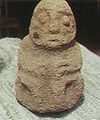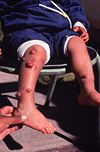- Carrion's disease
-
Carrion's disease Classification and external resources ICD-10 A44.0 (ILDS A44.800) ICD-9 088 DiseasesDB 1249 MeSH D001474 Oroya fever or Carrion's Disease is an infectious disease produced by Bartonella bacilliformis infection.
It is named for Daniel Alcides Carrión.[1]
Contents
History
Carrion's disease has been known since Pre-Inca times. Numerous artistic representations in clay (called "huacos") of the chronic phase have been found in endemic areas. The Spanish chronist, Garcilazo De La Vega described a disease with warts in Spanish troops during the conquest of Inca Empire, in Coaque-Ecuador. For a long time it was thought that the disease was endemic only in Peru and that it had only one phase, the "Peruvian wart" or "verruga peruana"[2]
In 1875 an outbreak, characterized by fever and anemia occurred in the region of construction of the railroad line between Lima and Oroya.[3] This is the source of the name "oroya fever" sometimes used to describe acute bartonellosis.[4]
In August 1885, Daniel Alcides Carrión, a Peruvian medical student, inoculated himself with material taken from a verruga lesion of a chronic patient (Carmen Paredes), with the help of a local physician (Evaristo Chavez). After 3 weeks he developed classic symptoms of the acute phase of the disease, thus establishing a common etiology (cause) for these two diseases. [5] He died from bartonellosis on October 5th, 1885 and was recognized as a martyr of Peruvian medicine and the term Carrión's Disease was used until our times (Peruvian Medicine Day is October 5 in honor to him).
Alberto Barton, a Peruvian microbiologist, identified Bartonella bacilliformis within erythrocytes in 1905, an announced the discovery of the etiologic agent (Barton bacillus) in 1909, which was called Bartonella bacilliformis.
Etiologic agent
It is caused by Bartonella bacilliformis.[6]
Epidemiology
Carrion's disease is found only in Peru, Ecuador, and Colombia.[7] It is endemic in some areas of Peru and is caused by infection with the bacterium Bartonella bacilliformis and transmitted by sandflies of genus Lutzomyia.[8]
Clinical signs and symptoms
The clinical symptoms of bartonellosis are pleomorphic and some patients from endemic areas may be asymptomatic. The two classical clinical presentations are the acute phase and the chronic phase, corresponding to the two different host cell types invaded by the bacterium (red blood cells and endothelial cells).
Acute phase: (Carrion's disease) the most common findings are fever (usually sustained, but with temperature no greater than 102°F (39°C)), pallor, malaise, nonpainful hepatomegaly, jaundice, lymphadenopathy, splenomegaly. This phase is characterized by severe hemolytic anemia and transient immunosuppression. The case fatality ratios of untreated patients exceeded 40% but reach around 90% when opportunistic infection with Salmonella spp occurs. In a recent study the attack rate was 13.8% (123 cases) and the case-fatality rate was 0.7%.
Chronic phase: (Verruga Peruana or Peruvian Wart) it is characterized by an eruptive phase, in which the patients develop a cutaneus rash produced by a proliferation of endothelial cells and is known as "Peruvian warts" or "verruga peruana". Depending of the size and characteristics of the lesions, there are three types: miliary (1-4 mm), nodular or subdermic and mular (>5mm). Miliary lesions are the most common.
The most common findings are bleeding of verrugas, fever, malaise, arthralgias, anorexia, myalgias, pallor, lymphadeopathy, and hepato-splenomegaly.
Diagnosis
Diagnosis during the acute phase can be made by obtaining a peripheral blood smear with Giemsa stain, Columbia-blood agar cultures, immunoblot, IFI, and PCR. Diagnosis during the chronic phase can be made using a Warthin-Starry stain of wart biopsy, PCR, and immunoblot.
Treatment
The drug of choice during the acute phase is Quinolones (such as ciprofloxacin)[9] or Chloramphenicol in adults and Chloramphenicol plus beta lactams in children.
For the chronic phase, Rifampin or macrolides are used to treat both adults and children.
See also
- Verruga peruana
References
- ^ synd/3112 at Who Named It?
- ^ Maguiña, C., 1998. Bartonellosis o Enfermedad de Carrión. A.F.A. Editores Importadores S.A., Lima.
- ^ DEVAULT VT (December 1952). "Treatment of bartonellosis with antibiotics". Ann. N. Y. Acad. Sci. 55 (6): 1222–7. doi:10.1111/j.1749-6632.1952.tb22686.x. PMID 13139205. http://www3.interscience.wiley.com/resolve/openurl?genre=article&sid=nlm:pubmed&issn=0077-8923&date=1952&volume=55&spage=1222.
- ^ Ellis BA, Rotz LD, Leake JA, et al. (August 1999). "An outbreak of acute bartonellosis (Oroya fever) in the Urubamba region of Peru, 1998". Am. J. Trop. Med. Hyg. 61 (2): 344–9. PMID 10463692. http://www.ajtmh.org/cgi/pmidlookup?view=long&pmid=10463692.
- ^ Schultz MG. Daniel Alcides Carrión (photo quiz). Emerg Infect Dis. 2010 Jun. Available from http://www.cdc.gov/EID/content/16/6/1025.htm Accessed 26 May 2010.
- ^ Maco V, Maguiña C, Tirado A, Maco V, Vidal JE (2004). "Carrion's disease (Bartonellosis bacilliformis) confirmed by histopathology in the High Forest of Peru". Rev. Inst. Med. Trop. Sao Paulo 46 (3): 171–4. doi:10.1590/S0036-46652004000300010. PMID 15286824. http://www.scielo.br/scielo.php?script=sci_arttext&pid=S0036-46652004000300010&lng=en&nrm=iso&tlng=en.
- ^ Maguina C, Garcia PJ, Gotuzzo E, Cordero L, Spach DH (September 2001). "Bartonellosis (Carrión's disease) in the modern era". Clin. Infect. Dis. 33 (6): 772–9. doi:10.1086/322614. PMID 11512081. http://www.journals.uchicago.edu/cgi-bin/resolve?CID001355.
- ^ Herrer, Arístides (1990). Epidemiología de la verruga peruana. Lima: L. Gonzales-Mugaburu.
- ^ Huarcaya E, Maguiña C, Torres R, Rupay J, Fuentes L (October 2004). "Bartonelosis (Carrion's Disease) in the pediatric population of Peru: an overview and update". Braz J Infect Dis 8 (5): 331–9. doi:/S1413-86702004000500001 (inactive 2009-09-26). PMID 15798808. http://www.scielo.br/scielo.php?script=sci_arttext&pid=S1413-86702004000500001&lng=en&nrm=iso&tlng=en.
External links
Categories:- Bacterial diseases
- Insect-borne diseases
- Tropical diseases
- Neglected diseases
- Bacterium-related cutaneous conditions
Wikimedia Foundation. 2010.



